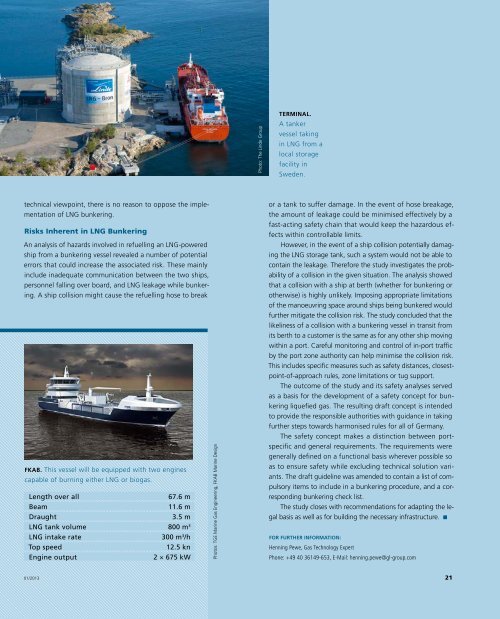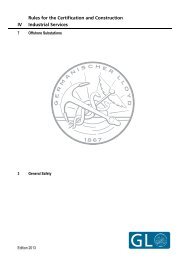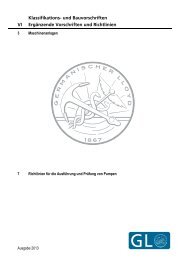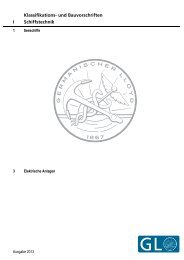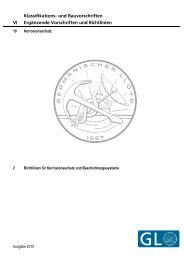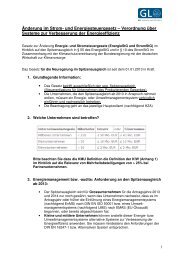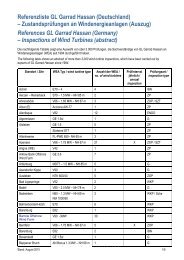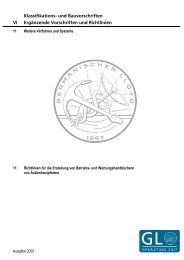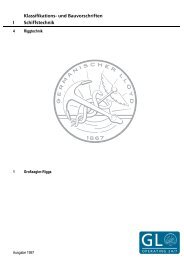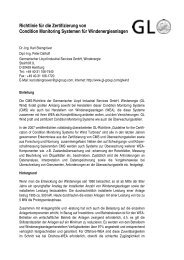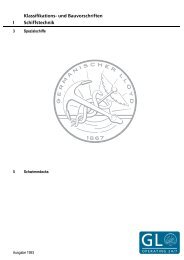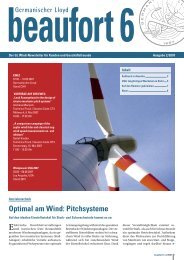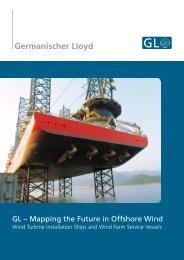Ways to Conserve Energy on Board - DNV
Ways to Conserve Energy on Board - DNV
Ways to Conserve Energy on Board - DNV
You also want an ePaper? Increase the reach of your titles
YUMPU automatically turns print PDFs into web optimized ePapers that Google loves.
Pho<str<strong>on</strong>g>to</str<strong>on</strong>g>: The Linde Group<br />
Terminal.<br />
A tanker<br />
vessel taking<br />
in LNG from a<br />
local s<str<strong>on</strong>g>to</str<strong>on</strong>g>rage<br />
facility in<br />
Sweden.<br />
technical viewpoint, there is no reas<strong>on</strong> <str<strong>on</strong>g>to</str<strong>on</strong>g> oppose the implementati<strong>on</strong><br />
of LNG bunkering.<br />
Risks Inherent in LNG Bunkering<br />
An analysis of hazards involved in refuelling an LNG-powered<br />
ship from a bunkering vessel revealed a number of potential<br />
errors that could increase the associated risk. These mainly<br />
include inadequate communicati<strong>on</strong> between the two ships,<br />
pers<strong>on</strong>nel falling over board, and LNG leakage while bunkering.<br />
A ship collisi<strong>on</strong> might cause the refuelling hose <str<strong>on</strong>g>to</str<strong>on</strong>g> break<br />
FKAB. This vessel will be equipped with two engines<br />
capable of burning either LNG or biogas.<br />
Length over all<br />
67.6 m<br />
Beam<br />
11.6 m<br />
Draught<br />
3.5 m<br />
LNG tank volume 800 m 3<br />
LNG intake rate 300 m 3 /h<br />
Top speed<br />
12.5 kn<br />
Engine output<br />
2 × 675 kW<br />
Pho<str<strong>on</strong>g>to</str<strong>on</strong>g>s: TGE Marine Gas Engineering, FKAB Marine Design<br />
or a tank <str<strong>on</strong>g>to</str<strong>on</strong>g> suffer damage. In the event of hose breakage,<br />
the amount of leakage could be minimised effectively by a<br />
fast-acting safety chain that would keep the hazardous effects<br />
within c<strong>on</strong>trollable limits.<br />
However, in the event of a ship collisi<strong>on</strong> potentially damaging<br />
the LNG s<str<strong>on</strong>g>to</str<strong>on</strong>g>rage tank, such a system would not be able <str<strong>on</strong>g>to</str<strong>on</strong>g><br />
c<strong>on</strong>tain the leakage. Therefore the study investigates the probability<br />
of a collisi<strong>on</strong> in the given situati<strong>on</strong>. The analysis showed<br />
that a collisi<strong>on</strong> with a ship at berth (whether for bunkering or<br />
otherwise) is highly unlikely. Imposing appropriate limitati<strong>on</strong>s<br />
of the manoeuvring space around ships being bunkered would<br />
further mitigate the collisi<strong>on</strong> risk. The study c<strong>on</strong>cluded that the<br />
likeliness of a collisi<strong>on</strong> with a bunkering vessel in transit from<br />
its berth <str<strong>on</strong>g>to</str<strong>on</strong>g> a cus<str<strong>on</strong>g>to</str<strong>on</strong>g>mer is the same as for any other ship moving<br />
within a port. Careful m<strong>on</strong>i<str<strong>on</strong>g>to</str<strong>on</strong>g>ring and c<strong>on</strong>trol of in-port traffic<br />
by the port z<strong>on</strong>e authority can help minimise the collisi<strong>on</strong> risk.<br />
This includes specific measures such as safety distances, closestpoint-of-approach<br />
rules, z<strong>on</strong>e limitati<strong>on</strong>s or tug support.<br />
The outcome of the study and its safety analyses served<br />
as a basis for the development of a safety c<strong>on</strong>cept for bunkering<br />
liquefied gas. The resulting draft c<strong>on</strong>cept is intended<br />
<str<strong>on</strong>g>to</str<strong>on</strong>g> provide the resp<strong>on</strong>sible authorities with guidance in taking<br />
further steps <str<strong>on</strong>g>to</str<strong>on</strong>g>wards harm<strong>on</strong>ised rules for all of Germany.<br />
The safety c<strong>on</strong>cept makes a distincti<strong>on</strong> between portspecific<br />
and general requirements. The requirements were<br />
generally defined <strong>on</strong> a functi<strong>on</strong>al basis wherever possible so<br />
as <str<strong>on</strong>g>to</str<strong>on</strong>g> ensure safety while excluding technical soluti<strong>on</strong> variants.<br />
The draft guideline was amended <str<strong>on</strong>g>to</str<strong>on</strong>g> c<strong>on</strong>tain a list of compulsory<br />
items <str<strong>on</strong>g>to</str<strong>on</strong>g> include in a bunkering procedure, and a corresp<strong>on</strong>ding<br />
bunkering check list.<br />
The study closes with recommendati<strong>on</strong>s for adapting the legal<br />
basis as well as for building the necessary infrastructure.<br />
For further Informati<strong>on</strong>:<br />
Henning Pewe, Gas Technology Expert<br />
Ph<strong>on</strong>e: +49 40 36149-653, E-Mail: henning.pewe@gl-group.com<br />
01/2013<br />
21


